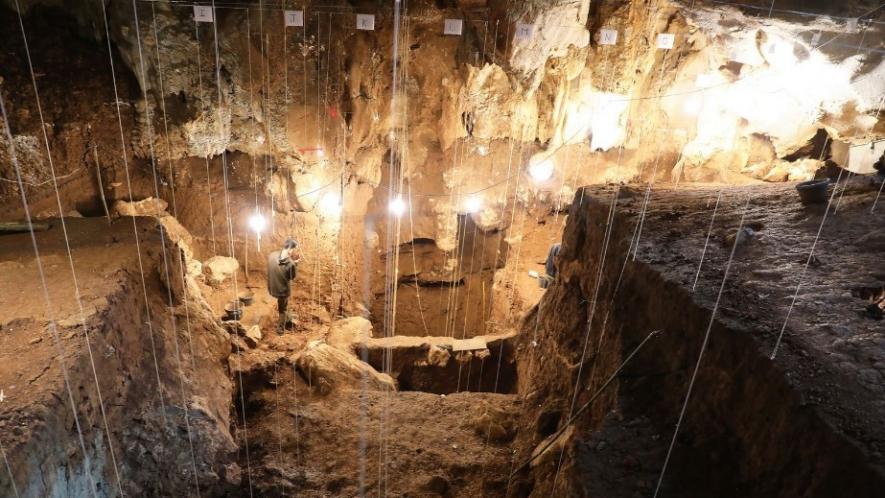Fossil Discoveries in Laos Suggest Earlier Arrival of Modern Humans to Southeast Asia

Image courtesy: Twitter
We know that all the people around the world today can trace their roots back to the people who migrated out of Africa thousands of years back. But when did the first batch of early modern humans arrive in Southeast Asia? Earlier than what was believed it seems, according to the findings of the latest research.
The time of arrival of modern humans in Southeast Asia is a topic actively researched and has remained quite elusive; however, the latest findings have shed some new light on it.
In the research published in Nature Communication on June 13, scientists analysed a pair of bones excavated from a cave in Laos and dated them between 68,000 to 86,000 years ago. The findings are fascinating not only from the Asian perspective but also for rethinking about out-of-Africa migration of modern humans. The research was focused on a cave in Northern Laos named Tam Pa Ling, which was once inhabited by early modern humans.
STORY BEHIND THE FINDINGS
The Tam Pa Ling (TPL) is a massive, sloping cave situated high in the Annamite mountain range in Northern Laos. The TPL cave was first explored for searching the presence of early modern humans in the year 2009 and at that time, Laura L Shackelford, currently an anthropologist at the University of Illinois, Urbana-Champaign, was one of the scientists involved in it. In the excavation of 2009, Shackelford and her team reported about finding modern human cranium (The bones that form the head) at the TPL cave, which was named as TPL 1. Shackelford is also the corresponding author of the latest Nature Communication paper. Since then, she has teamed up with other scientists to excavate early human remnants and pave the path for getting a clearer picture of early human migration.
The latest study reports finding two bones – one is a tibial fragment and the other is a frontal bone of the skull. The tibia is the leg bone which supports the weight of our body. The frontal bone and the tibial fragment have been named TPL 6 and TPL 7 respectively. Notably, the bone names indicate that seven bones have been excavated from the TPL since it was explored for the first time in 2009.
Over more than a decade of painstaking exploration in the TPL cave, Shackelford and her team have produced a chronology of the cave with the help of data extracted till now. Sediments and bones sandwiched between the layers of clay in the cave have shown that modern humans inhabited the cave for at least 68,000 years. This provides a remarkable clue about human migration out of Africa to Southeast Asia.
The latest discovery of the bones may be what remains after floods washed through the cave. In fact, the cave may not have provided permanent shelter to anybody as floods swept through it every year, washing away the sediments and bones from the surface to the depths. Therefore, whatever the researchers have obtained from it was from the layers. Fortunately, fragments of bones remained in some of the layers. The researchers had to excavate as deep as 7 meters to obtain the fossils.
The researchers also dated some of the herbivore teeth found there alongside the early modern human fossils using advanced techniques like electron spin resonance or uranium series dating. They calculated the age of the sediments with the help of the technique known as luminescence dating to know when light particles or photons last hit the soil.
From their analyses, the most recently discovered skull and leg bones are dated around 70,000 to 77,000 years old. However, the leg bone can be as old as 86000 years.
As the authors of the latest study write, the African origin of the Homo sapiens can be traced back to 3,00,000 years back, which fossil and genetic evidence suggest. Human dispersal after that and especially to Eurasia is immensely debated. The out of Africa migration to this region falls into two time periods; one is during the MIS (Marine Isotope Stage)-5 which is the period 1,30,000 to 80,000 years ago and the second is during the post-MIS 5 period. Shackelford and her team’s excavation in 2009-2010 led to the discovery of Homo sapiens skull and jawbone that dated around 46,000 years old.
Based on DNA analyses, some hypotheses suggest that early modern humans dispersed from Africa in a single wave during a period after the MIS 5 stage. The Laos fossils from the TPL cave, however, suggest otherwise – that dispersal to this region occurred much before the MIS5 stage was over.
Worth mentioning here is that one of the earliest evidence of human presence in Australia dates back to 65,000 years ago based on the stone tools and charcoal found in Madjedbede, a shallow cave in northern Australia. Laos is situated at a crucial location in the migration route to Australia.
In Sumatra, in the year 2017, H sapiens teeth were found in the Lija Aver cave that were estimated to be 70,000-46,000 years old and stone tools were found in central India (which were human-made) aged 74,000 years, as was referred by Michael Price in an article about the Laotian fossils published in Science. However, all of these findings have been questioned by other experts in the field.
A decade-long excavation effort by Shackelford and others has led to the discovery of some crucial information about early migration to Southeast Asia. Shackelford says she will continue to excavate more in the cave in search of more fossils and newer information. In her words, “This is just a mountain, there are thousands of caves to explore.”
Get the latest reports & analysis with people's perspective on Protests, movements & deep analytical videos, discussions of the current affairs in your Telegram app. Subscribe to NewsClick's Telegram channel & get Real-Time updates on stories, as they get published on our website.














